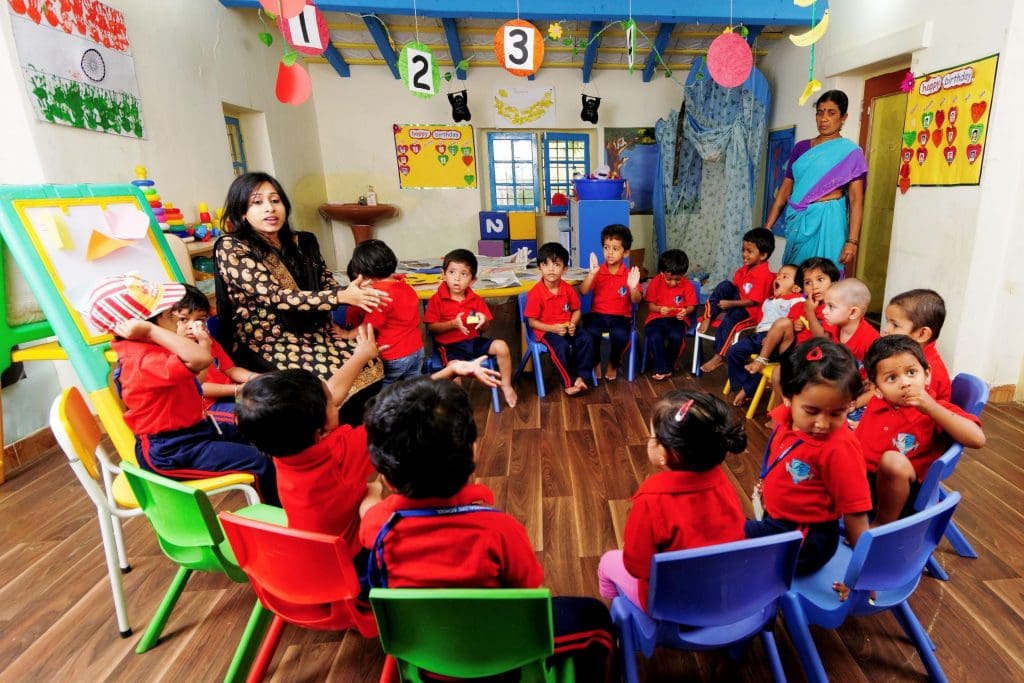By B S Yadav
Principal
DPS, Jodhpur

When we think of “Early Learning” the first thing which comes to our mind is Preschool but the research proves that learning begins in the womb itself (Christine Moon, lead author and professor of psychology). We can take the example of Abhimanyu learning the technique of Chakra-vyuhu while still in his mother’s womb. Research evidences in the field of neuroscience say that by the age of two, the brain reaches 3/4 of adult size and by five, it becomes very close to the adult size. (Data from Dekaban A.S and Sadowsky). The children learn from the environment around much more than the elders hence it is very important that they are exposed to the positive and stress free surroundings.
Both nature and nurture affect the child’s physical, cognitive, emotional and social development. Traditionally in Indian context the early learning at home was considered to inculcate the basic values and social skills in children in the form of Sanskaars. The children were not sent for formal education till they attained the age of 6-7 years. Substantial early care and education of the children was informal, within the family and mostly by the elders.
Nowadays change in the family structure from joint to nuclear and increase in the number of working parents, single parents, has laid the seeds for the concept of Early Childhood Education where the children come to the school at the age of 2.5-3 years. After careful contemplation over such factors, we in our school follow many practices as mentioned below:
1. Enhancement of the Domains of Development
a) Physical (fine and gross motor)
Crumpling, tearing and pasting, sand pit activity, balancing, crawling, climbing up and down on Rope Bridge etc.
b) Socio-emotional
Theme based assemblies, storytelling, role plays, building blocks, circle time, meet my buddy etc.
c) Language
Know me better (where child speaks about his interest, likes and dislikes), class library, word wall, conversation time, rhymes and stories, puppet show, puzzles, scrabble etc.
2. Focusing on the Different Modes of Learning
Different techniques are used to meet the need of different types of learners. For example Swars in Hindi are introduced through rhymes and stories which serve the needs of auditory learners. Pictorial calendars, flash cards and live objects quench the thirst of visual learners whereas floor chart activities satisfy the requirement of kinaesthetic learners.
3. Flexible Curriculum
The curriculum made for these learners comprises of:
- Catering to the need of individual learner
- Focusing on Multiple Intelligence
- Spirals (worksheets) are made by teachers.
- More of activity based assessments.
- In-house teaching aids.
4. Incorporation of Integration of Subjects
Subjects are integrated which not only help children to make meaningful and relevant connections but also develop in them the skill of applying acquired knowledge when and wherever required. For example when” Food” is taught under the subject EVS following subjects are integrated:
Maths– counting of fruits and vegetables.
English– spellings of fruits.
Hindi– rhymes on importance of food, names of fruits and vegetables.
These are some of the areas widely used in early education centres but more than that is exposure and freedom given to the children grow in their own way with little support from outside. There was importance of ECE in the past and will continue in future also but the same should be informal in nature. So the ECE centres must act as home away from home and should not change into a formal school.
5. Values
Values and sanskaars are very important in the life of a human being and the same are best imbibed at an early age. For this story telling and enactment in the room or on the stage are also useful.
6. Thematic Learning
A variety of activities are so well amalgamated that all the subtopics under the theme are well absorbed. For e.g. the theme animal can be taught through following activities:
- Assemblies
- Puzzles
- Role plays
- Nature walk
- Activity sheets
- Bulletin boards

7. Orientation Programs for Parents
Orientation programs conducted in school provide opportunities to talk about better parenting, health and nutrition and spending quality time with the children. It also strengthens the bond between teacher, child and parent thus enhancing better learning.
These practices prepare the child in smooth transition to primary school for formal education.
The responsibilities of the Early Childhood educators will definitely increase in the coming years as the society is heading towards single parenthood and digital world. We all together need to invest in these critical years of the toddlers – the world’s greatest resource. As quoted by Ed Markey “Education is not only a ladder of opportunity but also an investment in our future.”
These are some of the areas widely used in early education but more than that it is the exposure and freedom given to the children to grow in their own way with little support from outside.


